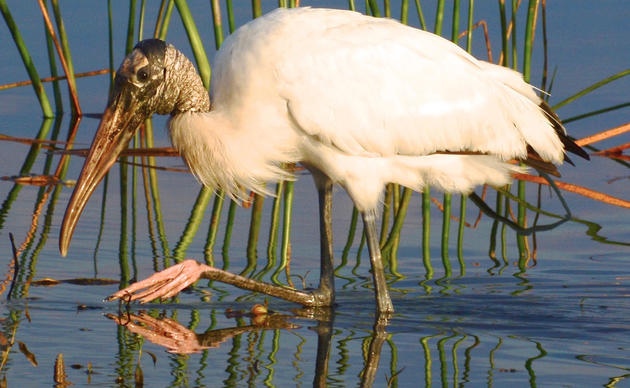Audubon's Corkscrew Swamp Sanctuary was recognized as a Wetland of Distinction by the Society of Wetland Scientists in spring 2019, and that honor was reported in the Tropicalia section of the Fort Myers News-Press on April 28 and in Florida Weekly on May 2.
Here's a copy of the story:
Corkscrew Swamp Sanctuary receives international wetland designation
Wildfires and fouled beaches emphasize important role of wetlands
Audubon's Corkscrew Swamp Sanctuary has become the first wetland in the southern United States to be recognized as a Wetland of Distinction by the Society of Wetland Scientists. "We're honored to receive this international recognition," said Research Director Dr. Shawn Clem of the Western Everglades Research Center at Corkscrew Swamp Sanctuary.
The Society of Wetland Scientists noted several of Corkscrew's exemplary ecosystem services, including aquifer recharge, flood storage, carbon storage, and water quality improvement, in addition to community services like recreation, education, and aesthetic value. They also highlight the important role the Sanctuary plays as habitat for endangered species, including Wood Storks, Florida Panthers, Florida Bonneted Bats, and several species of orchids.
The Sanctuary has received many national and international accolades in its 65 years under Audubon stewardship, including being named a Ramsar Wetland of International Importance, an Important Birding Area, a National Natural Landmark, and a gateway to the Great Florida Birding and Wildlife Trail.
The Wetland of Distinction initiative was created in 2017 “to promote awareness, appreciation, and knowledge of some of the country’s most ecologically sensitive landscapes.”
“While sanctuary visitors can easily see Corkscrew’s beauty and experience the power of ‘nature therapy,’ the importance of our wetlands for local, regional and global ecology can be more difficult to appreciate,” said Dr. Clem.
“Our staff takes the responsibility of protecting and maintaining Corkscrew’s natural habitats very seriously. Events of the past few years clearly demonstrate the importance of inland wetlands like Corkscrew for buffering dry season wildfires, as well as, wet season water storage, aquifer recharge, and natural cleansing of water before it reaches our treasured estuaries and beaches. Audubon’s Corkscrew Swamp Sanctuary provides incredible birding and wildlife viewing and is a true ecological treasure.”
A National Audubon Society sanctuary, Corkscrew Swamp Sanctuary’s 13,000 acres are central to the over 60,000-acre Corkscrew Regional Ecosystem Watershed. The watershed collects seasonal rainfall across the region, provides drinking water for inland and coastal residents from Naples to Estero, and provides freshwater to the Estero, Imperial, and Cocohatchee Rivers. A popular tourism destination, the remote Corkscrew Swamp Sanctuary is visited by 100,000 people from around the world each year.
Efforts to protect the sanctuary’s old-growth bald cypress from logging operations in the 1940s and ‘50s created the largest remaining old growth bald cypress forest in the world. These old growth bald cypress trees once supported the largest Wood Stork colony in North America, although the colony has struggled in recent decades due to changes in regional land use and hydrology, including destruction of much of the region’s unique shallow wetlands. Reversing these changes through wetland conservation and restoration has been a primary focus for Audubon and its regional partners.
A major initiative now underway is an effort to restore 1,000 acres of marsh and prairie wetland at Corkscrew Swamp Sanctuary, an ambitious five-year goal with a price tag of $2 million. The work is considered vital to ensuring the health of Southwest Florida's wetlands, waterways and water supply. It costs $2,000 to restore a single acre of degraded wetland habitat. Corkscrew is currently working to restore 340 acres of wetland, with a goal of 1,000 restored acres. Information on the restoration project.




